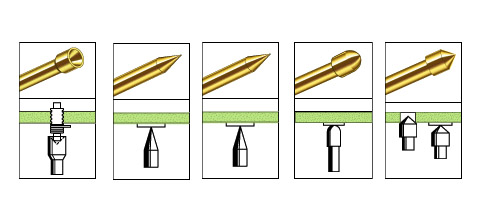Mechanical Considerations
Mechanical Considerations

Tip Style
IDI offers a variety of tip styles for each probe series. Some tips are more aggressive, ideal for penetrating contaminants, other are designed not to scour or mark the contact surface, while others are designed to specifically to contact vias – filled or unfilled. For more information to determine the best tip style for you applications, click here
Spring Force
The spring force is defined as the amount of force required to compress the probe to the recommended working travel. IDI offers a wide range of spring forces. Lower force springs are typically used in areas with a high probe density. Higher force springs are used for penetrating contaminated test points in lower density areas. For more detailed information on spring force, click here.
Operating Temperature
Lubrication and spring materials determine the operating temperature of a probe. Most all probes that are lubricated to increase mechanical life, have a maximum operating temperature of 120°C. Probes operating outside of this range should be non-lubricated. Spring material is the other factor affecting the maximum operating temperature of a probe. Various materials lose their spring properties (anneal) at different temperatures. The chart below lists the operating temperatures for the various spring materials lubricated and non-lubricated.
Recommended Minimum Centers
The recommended minimum centers, the minimum distance between the center-point of one mounting hole to the adjacent mounting holes.
Recommended Working Travel
The recommended working travel, also known as rated travel, is typically 2/3 of the maximum travel. Depending on the spring design, compressing a probe beyond its recommended working travel can create undue stress on the spring. Testing at full stroke can potentially damage the plunger tip or the device under test (DUT). If testing past recommended working travel is required, please contact IDI for assistance in choosing a probe for your specific requirements.
Maximum Travel
Maximum travel is the maximum distance that a probe may be compressed. The small body diameter of the probe controls the maximum travel if the probe tip is headless. If the probe tip is headed, the bottom of the tip making contact with the barrel controls the maximum travel distance. The maximum travel listed for each probe is based upon a nominally dimensioned part. It should be noted that the maximum travel has a tolerance of + .005″ (0,13)
